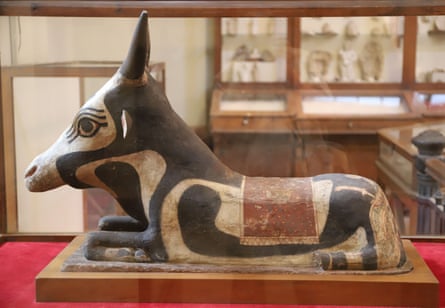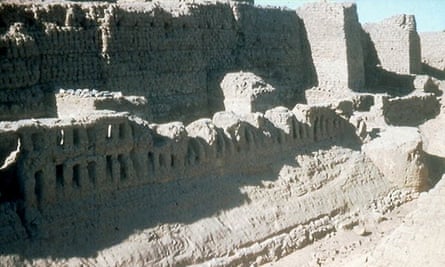When the Egyptian government under President Nasser decided to build the High Dam at Aswan in the 1950s, flooding lower Nubia and its archaeological sites, Unesco initiated an international campaign to save and relocate its monuments, including the temples of Abu Simbel and Philae, and the huge fortress of Buhen, just within Sudan.
The excavation of Buhen, which began in 1957, was the UK's major contribution to the campaign, funded by the Egypt Exploration Society, and directed by Bryan Emery, professor of Egyptology at University College London. Harry Smith, then a young Cambridge lecturer, joined the team in 1959, working at Buhen and other sites in Nubia until 1965.
Smith, who has died aged 96, went on to become one of the leading British Egyptologists of his generation, with the broadest range in philology, archaeology and history.
As a result of his work in Nubia, he produced a series of pioneering studies (1966-94) that began the process of reassessing the significance of early societies in Nubia and Sudan, and their development independent of Egypt.
He challenged the racist interpretations of earlier archaeologists, who claimed that prehistoric and early Nubian cultures were the product of population movements from the north and declined because of movements of so-called negro populations from the south.

Smith had first worked with Emery in Egypt at Saqqara, the vast cemetery of ancient Memphis, south of modern Cairo, as a graduate in 1953, rejoining him there in 1964 after being appointed reader in Egyptology at UCL.
When Emery retired in 1970, Smith took over his post as professor. Then, after Emery's sudden death the following year, Smith continued his work at Saqqara. The excavation's focus was the Sacred Animal Necropolis, miles of underground galleries containing millions of mummified animals in jars: from the shrew to the ibis to the baboon. Notable was the burial place of the sacred cows, the mothers of the living representative of the bull god, Apis, kept in the temple. Later, in 1982, he initiated a survey of Memphis with his former students David Jeffreys and Lisa Giddy, recording the remains of the principal city of Egypt for much of its ancient history.
Born in London, Harry grew up surrounded by archaeologists and antiquities. He was the son of Sidney Smith, keeper of Egyptian and Assyrian antiquities at the British Museum from 1931, and Mary (nee Parker), an artist who trained at the Slade School. Their closest friends were the archaeologist Max Mallowan and his wife, the crime writer Agatha Christie. Consequently, Harry, with his parents and younger sister, Zoë, spent many holidays at Christie's house, Greenway, in Devon. Christie later dedicated her 1965 novel, At Bertram's Hotel, to Harry, "because I appreciate the scientific way he reads my books".
He went to Merchant Taylors' school near Northwood, Hertfordshire, before winning a scholarship to study classics at Cambridge. Having completed national service, he took up his place at Christ's College, having switched to oriental studies (Egyptian, Coptic and Arabic).
Following his first season in Saqqara he was appointed assistant lecturer and research fellow at Christ's College (1954-63), where he began studying Demotic, an ancient Egyptian language. Although a fine philologist, Smith also wanted to be involved in fieldwork, so in 1959 went to Turkey and Iraq (Nimrud) to train in settlement archaeology, before arriving at Buhen.
In 1961, he married Hazel Flory Leeper, an administrator at Christ's College. She was the photographer for Smith's work in Nubia and at Saqqara, and ran the dig house at Saqqara with great efficiency. The couple made a home in Dulwich, south London, then, from the mid-70s, in Upwood, near Huntingdon, Cambridgeshire.

One of Smith's duties at UCL was overseeing the collection of 78,000 objects formed by Sir Flinders Petrie, ranging from the Palaeolithic to Islamic period. Smith and Barbara Adams, the curator, were deeply concerned about the fabric of the building holding the collection, and access to it for the public. After a fundraising campaign in 1986-87, Adams and Smith, with others, founded the Friends of the Petrie Museum in 1988. Smith was its president until 2021.
He retired as professor, and from excavation, in 1988, but continued to teach until 1994. He was inspiring and caring, greatly loved and respected by his students.
A tallish, spare figure, Smith was inclined to clumsiness, which led him to fall down holes and knock things over: not ideal in an archaeologist but endearing to many.
He served for many years on the committees of the Egypt Exploration Society (of which he was elected vice-president in 1994) and the Sudan Archaeological Research Society. He was elected a fellow of the British Academy in 1985.
Throughout his career, Smith published a considerable number of volumes and academic papers. The earlier years of his "retirement" were spent completing five volumes on the Sacred Animal Necropolis, with his friend and former student Sue Davies.
Hazel died in 1991. Smith is survived by two nephews.
-- Sent from my Linux system.

No comments:
Post a Comment